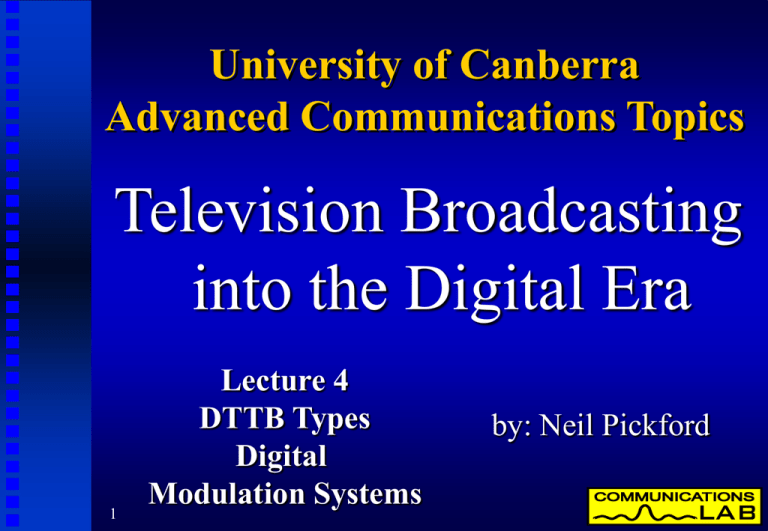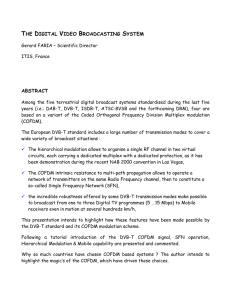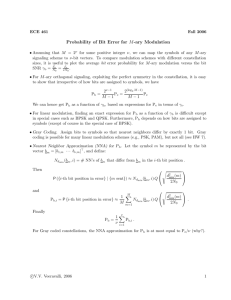Digital Television Talk Lecture 4
advertisement

University of Canberra Advanced Communications Topics Television Broadcasting into the Digital Era 1 Lecture 4 DTTB Types Digital Modulation Systems by: Neil Pickford Digital Terrestrial TV - Layers . . . provide clean interface points. . . . 1920 x 1080 1280 x 720 50,25, 24 Hz Picture Layer Video Compression Layer Data Headers Motion Vectors Multiple Picture Formats and Frame Rates MPEG-2 compression syntax ML@MP or HL@MP Chroma and Luma DCT Coefficients Variable Length Codes Flexible delivery of data Packet Headers Transport Layer Transmission Layer 2 Video packet Audio packet Video packet VHF/UHF TV Channel 7 MHz Aux data MPEG-2 packets COFDM / 8-VSB Digital Television Encode Layers Control Data Video Picture Coding Control Data MPEG-2 Data Data Coding Sound Audio Coding MPEG Transport Stream Mux Program 1 Multiplexer Program 2 Other Data Control Data MPEG-2 or AC-3 Program 3 Service Mux Bouquet Multiplexer MPEG Transport Data Stream 188 byte packets Control Data Modulator & Transmitter Delivery 3 System Error Protection Digital Television Decode Layers MPEG-2 Transport Stream Mon Data Picture Decoder Data Decoder MPEG Transport Stream De-Multiplexer Demodulator & Receiver Delivery 4 System Speakers Audio Decoder MPEG DeMux Error Control MPEG or AC-3 Set top Box (STB) - Interfacing Domestic and Professional interfaces still to be defined Most probably Transport Stream via IEEE 1394 (Firewire) Baseband Audio & RGB/YUV Video signals. STB can convert between line standards so you do not have to have a HD display. Display and transmitted information must be at same Frame/Field rate. (25/50) 5 DTTB - Content & Services DTTB was designed to carry video, audio and program data for television DTTB can carry much more than just TV Electronic program guide, teletext Broadband multimedia data, news, weather Best of internet service Interactive services Software updates, games 6 Services can be dynamically reconfigured DVB Data Containers MPEG Transport Stream is used to provide DVB “data containers” which may contain a flexible mixture of: Video Audio Data services Streams with variable data rate requirements can be Statistically Multiplexed together. Allows channel 7 Six 2 Mb/s programs to be placed in a 8 Mb/s Examples of DVB Data Containers Channel bandwidth can be used in different ways: SDTV 1 SDTV 2 SDTV 3 HDTV 1 SDTV 4 SDTV 5 Multiple SDTV programs 8 HDTV 1 SDTV 1 Single HDTV program Simulcast HDTV & SDTV Video Program Capacity For a payload of around 19 Mb/s 1 HDTV service - sport & high action 2 HDTV services - both film material 1 HDTV + 1 or 2 SDTV non action/sport 3 SDTV for high action & sport video 6 SDTV for film, news & soap operas However you do not get more for nothing. More services means less quality 9 Spare Data Capacity 10 Spare data capacity is available even on a fully loaded channel. Opportunistic use of spare data capacity when available can provide other non real time data services. Example: 51 second BMW commercial The Commercial was shown using 1080 Lines Interlaced. 60 Mb of data was transferred during it. In the Final 3 seconds the BMW Logo was displayed allowing 3 Phone Books of data to be transmitted. Enabling Technologies Source digitisation (Rec 601 digital studio) Compression technology (MPEG, AC-3) Data multiplexing (MPEG) Transmission technology (modulation) Display technology (large wide screens) Production 11 Digital Television - Types Terrestrial (DTTB) DVB-T / 8-VSB Free to air TV (broadcasting) Narrowcasting/value added services Untethered - portable reception 12 Digital Terrestrial Television Broadcasting - DTTB Regional free to air television Replacement of current analog PAL broadcast television services Operating in adjacent unused “taboo” channels to analog PAL service Carries a range of services HDTV, SDTV, audio, teletext, data Providing an un-tethered portable service 13 Transmission Technology The transmission system is used to transport the information to the consumer. The system protects the information being carried from the transmission environment Current Australian analog television uses the PAL-B AM modulation system 14 Digital TV Transmission Technology The transmission system is a “data pipe” Transports data rates of around 20 Mb/s Transports data in individual containers called packets 4 15 Digital TV Transmission Systems Australia has been following Digital TV & HDTV Europeans - Digital SDTV - 8 MHz on UHF - DVB-T (COFDM) Americans - Digital HDTV - 6 MHz VHF/UHF - ATSC (8-VSB) Japanese - Integrated Broadcasting - ISDB (BST-OFDM) 16 8-VSB - USA Developed by the advance television systems committee - ATSC Developed for use in a 6 MHz channel A7 17 MHz variant is possible but has not been produced. Uses a single carrier with pilot tone 8 level amplitude modulation system Single Payload data rate of 19.39 Mb/s Relies on adaptive equalisation Existing AM technology highly developed COFDM - Europe Developed by the digital video broadcasting project group - DVB Uses similar technology to DRB Uses 1705 or 6817 carriers Variable carrier modulation types are defined allowing Payload data rates of 5-27 Mb/s in 7 MHz Developed for 8 MHz channels A7 18 & 6 MHz variants have been produced and tested. Can use single frequency networks - SFNs New technology with scope for continued improvement & development ISDB - Japan Japanese are developing integrated services digital broadcasting (ISDB) System integrates all forms of broadcasting services into one common data channel which can be passed by satellite, cable or terrestrial delivery systems Video services Sound services Bulk data services Interactive data services 19 ISDB - Concept 20 Proposed to use band segmented transmission orthogonal frequency division multiplex (BST-OFDM) Terrestrial Transmission Problems Multipath interference - ghosts Noise interference - snow Variable path attenuation - fading Interference to existing services Interference from other services Channel frequency assignment where to place the signal 21 Digital Modulation - Functions Spreads the data evenly across the channel Distributes the data in time Maintains synchronisation well below data threshold Employs sophisticated error correction. Equalises the channel for best performance 22 Digital Modulation Two techniques: Conventional Single Carrier 8VSB Multicarrier/Spread OFDM Spectrum 8-VSB & COFDM - Spectrum 8-VSB COFDM 24 Sin(x)/x 25 Digital Modulation Spectrum of Conventional Multi-Phase Keyed Carrier Fc at Symbol Rate Fs Amplitude, dB Sin X/X shaping Frequency Fc - Fs Fc Fc + Fs Digital Modulation Low Symbol Rate Amplitude, dB Medium Symbol Rate High Symbol Rate Frequency PSK Digital Information Phase Shift Keying Modulation 28 BPSK Modulation 0 1 180 Deg Phase Change 29 I AXIS QPSK Modulation Q AXIS 10 11 QPSK Distance 00 30 I AXIS 01 16QAM Modulation Q AXIS 16-QAM Distance 1110 10 1111 11 1100 1101 I AXIS 0010 0011 01 00 0000 31 0001 8VSB Modulation Q AXIS 16-QAM Distance 1110 10 1111 11 1100 1101 I AXIS 0010 0011 01 00 0000 32 0001 Hierarchical Modulation Hierarchical Distance Q AXIS 1110 10 1111 11 1100 1101 QPSK Distance 0010 I AXIS 0011 01 00 0000 33 0001 Digital Modulation Amplitude Typical Filtered Spectrum to give about half original bandwidth Occupied Channel Bandwidth Frequency Fc - Fs Fc Fc + Fs 8-VSB Digital Modulation Application of Vestigial Sideband Filter to give reduced spectral occupancy BUT with destruction of pure Amplitude modulation causing incidental Phase modulation but some power in a small carrier Amplitude Occupied Channel Bandwidth eg 6 MHz in US Frequency Fc - Fs Fc Fc + Fs 8VSB uses symbol Rate with period 93 nanoseconds Normal FDM Guard Band Carrier 1 Amplitude, dB Carrier 2 Frequency Traditional SCPC Modulation Minimum Carrier Spacing Frequency 37 Orthogonal Modulation Amplitude, dB Frequency Orthogonal Modulation Amplitude, dB Frequency COFDM - Orthogonal Carriers Frequency 40 Spectrum of COFDM DTTB Carrier Spacing 2k Mode 3.91 kHz 8k Mode 0.98 kHz Almost Rectangular Shape 1705 or 6817 Carriers 6.67 MHz in 7 MHz Channel 41 OFDM Occupied bandwidth is: No. of Carriers x Spectral Width. Create with FFT Spectral Width 2k is 4x wider than 8k Amplitude, dB Fcentre Frequency DIGITAL TERRESTRIAL BROADCASTING Among the four Digital Broadcasting standards available, three are based on the Coded Orthogonal Frequency Division Multiplex modulation.... Why ? Distant transmitter Nearest transmitter The Terrestrial Broadcasting has to cope with multipath propagation and Doppler effects: COFDM is the response for these impairments ! COFDM : HOW ? 1 - Organize time & frequency partitions in the RF channel time RF Channel bandwidth frequency sub-band time segment frequency 44 COFDM : HOW ? 2 - Spread sub-carriers over “time vs frequency” cells time OFDM symbol Make sub-carriers orthogonal to avoid “inter-carriers” interference frequency 45 COFDM : HOW ? 3 - Insert Guard Interval to avoid “inter-symbol” interference Guard Interval duration Useful symbol duration time OFDM symbol frequency Guard interval introduces a first loss in transport capacity 46 COFDM : HOW ? 4 - Insert “Synchronization Pilots” Helps Receivers to lock onto the signal OFDM Frame (68 OFDM symbols) time frequency 47 FFT time windows for receivers Synchronization markers introduce the second loss in transport capacity COFDM : HOW ? 5 - Prepare data to be carried on OFDM symbols DATA to broadcast Protected DATA (convolutionnal error protection codes) time frequency 48 Protection codes introduce the third loss in transport capacity COFDM : HOW ? 6 - Map bits onto OFDM: Spread contiguous data bits over distant sub-carriers DATA to broadcast Protected DATA 0 1 0 0 1 time frequency 49 Create frequency diversity to improve robustness against fading DTTB - Channel Estimation The Terrestrial transmission channel is continuously varying (position & time) Variations occur in Amplitude, Phase & Frequency To correct for this variation Information needs to be added to the transmission to quantify the channels response at any instant Equalisers in the Digital receiver use this information to remove these transmission impairments 50 Data Multiplex - 8-VSB 4 828 Symbols Field Sync #1 313 Segments S e g m e n t S y n c 313 Segments Data + FEC Field Sync #2 Data + FEC Test Segment 51 24.2 ms 1 Segment = 77.3 us 24.2 ms 8-VSB Segment Sync & Data +7 +5 +3 +1 -1 -3 -5 -7 Levels Before Pilot Addition (Pilot=1.25) Data Segment SYNC Data + FEC Data Segment SYNC 4 Symbols 828 Symbols 207 Bytes 4 Symbols Data Segment 832 Symbols 208 Bytes Symbol Duration 93 ns 52 Digital Modulation - 8-AM 7 6 5 4 Before Equaliser 3 2 1 0 After Equaliser 8-VSB - Coaxial Direct Feed through Tuner on Channel 8 VHF 3 Bits/Symbol 53 8-VSB - Field Sync Precode* 832 Symbols +7 +5 +3 +1 -1 -3 -5 -7 PN511 PN63 PN63 PN63 VSB Mode Reserved Sync Levels Before Pilot Addition (Pilot=1.25) 4 Symbols 511 Symbols 63 63 24 63 Sym- Sym- Sym- Symbols bols bols bols 104 Symbols * For trellis coded terrestrial 8 VSB the last 12 symbols of the previous segment are duplicated in the last 12 reserved symbols of the field sync. Field Sync is Repeated Every 24 ms 54 12 Symbols 8-VSB - Field Sync 7 6 5 4 Before Equaliser 55 3 2 1 0 After Equaliser 8-VSB Frame 832 Training Sequence Symbols per Data Segment S of 77.3 µs y n c Data 313 Data Segments of 24.2 ms Training Sequence Data The Training Sequence is only 0.3% of signal time Total Sync is only 0.8% of time DVB-T - Carriers + Pilots 0.977/3.906 kHz Kmin Kmax = 1704 for 2K or 6816 for 8K Kmax SYMBOLS IN SEQUENCE - 68 PER BLOCK. 57 Modulated Carriers Scattered Pilots DVB-T Super Frame 34 50 TPS Carriers 17/68 Super 1512: Frame Frame 1 4 x 68 Frame 2 in 2k Frame 3 6048: 1705 Symbols = 6817 N MPEG Frame 4 in 8k Packets 48 58 54 Fixed Pilots Co- Incident with Scattered pilots 45/177 DVB-T Transmission Frame Kmin=0 59 2k mode - 3906 Hz - Kmax=1704 Carrier Spacing & Position 8k mode - 977 Hz - Kmax=6816 Kmax Data TPS - Pilot Scattered Pilot Continuous Pilot Symbol Duration 256 us (2k) or 1024 us (8k) DVB-T - Estimating the Channel A B C D E A B=3/4A+1/4E C=1/2(A+E) D=1/4A+3/4E E A to E - 1.024 ms (2k) - 4.096 ms (8k) For a varying transmission channel DVB-T estimation is 23.5 times faster than ATSC 60 DVB-T - Estimating the Channel AB C DE FG AB C DE FG B=2/3A+1/3D C=1/3A+2/3D E=2/3D+1/3G F=1/3D+2/3G A to D - 11.724 kHz (2k) - 2.931 kHz (8k) For a varying transmission channel DVB-T estimation is 23.5 times faster than ATSC 61 Channel Estimation & Equalisation ATSC Time DVB-T Time 62 Estimation Rate Comparison ATSC Equaliser is updated every 24 ms (~260 000 symbols) DVB-T Equaliser is updated every symbol period (256 us). 1/12 of data carriers are pilots DVB-T Full Channel estimate is available every 4 symbols (1.024 ms) For a varying transmission channel DVB-T estimation is at least 23.5 times faster than ATSC 63 OFDM - Features Multicarrier - many carriers sharing Reduced C/N compared to Analogue Resistant to echoes, Interference etc Low symbol rate per carrier ~ 1 kBaud: Long Symbol Period, can Extend with Guard Interval With FEC becomes COFDM Uses Fast Fourier Transform [FFT] ”2k” and “8k” versions 64 Single Frequency Networks [SFN]




